 Leading Blog | Posts by Month |
 Leading Blog | Posts by Month |
04.30.20

LeadershipNow 140: April 2020 Compilation
See more on
Posted by Michael McKinney at 02:16 PM

Leading Thoughts for April 30, 2020
IDEAS shared have the power to expand perspectives, change thinking, and move lives. Here are two ideas for the curious mind to engage with: Astronaut Chris Hadfield on the power of knowing what could go wrong: “In order to stay calm in a high-stress, high-stakes situation, all you really need is knowledge. … Feeling ready to do something doesn’t mean feeling certain you’ll succeed, though of course that’s what you’re hoping to do. Truly being ready means understanding what could go wrong—and having a plan to deal with it. … Being forced to confront the prospect of failure head-on—to study it, dissect it, tease apart all it’s components and consequences—really works. After a few years of doing that pretty much daily, you’ve forged the strongest possible armor to defend against fear: hard-one competence.” Source: An Astronaut's Guide to Life on Earth: What Going to Space Taught Me About Ingenuity, Determination, and Being Prepared for Anything Richard P. Feynman on leaving room for doubt so that the door is open to critical thinking and learning: “A scientist is never certain. We all know that. We know that all our statements are approximate statements with different degrees of certainty; that when a statement is made, the question is not whether it is true or false but rather how likely it is to be true or false. … Scientific knowledge is a body of statements of varying degrees of certainty -- some most unsure, some nearly sure, none absolutely certain.” Source: The Pleasure of Finding Things Out: The Best Short Works of Richard P. Feynman Look for these ideas every Thursday on the Leading Blog. Find more ideas on the LeadingThoughts index.
Posted by Michael McKinney at 07:13 AM
04.29.20

The Grace to Show Respect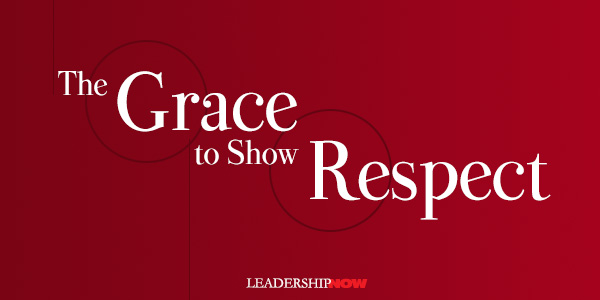
IF WE are to be successful, we need to collaborate. We don’t have the whole story. Collaboration is founded on a bedrock of respect. John Baldoni writes in Grace: A Leader’s Guide to A Better Us, “Our culture has become more coarsened. The rancor in our political system, fueled as it is by people who do not want to listen to one another, paralyzes so much of our public discourse.” It is difficult to find a voice today that is not hindered by personal biases, political affiliations, pandering, sarcasm, and name-calling. We all need—and leaders, especially—a good dose of grace. We stop listening when we think we know all there is to know, and we are convinced we are right. We believe that belittling other’s ideas that are in opposition to our own becomes a necessary step in protecting our own views. Instead, ask yourself, Why are they making that choice? Tom Peters wrote in The Little Big Things, “Connect! Listen! Get the Story! (Remember: Everyone [every single one] has a story.)” In a time of crisis, we have to remember that not only do we not know everything, but those we look to for answers, don’t know everything. We have to assume, as former CEO and Chairman of Aetna Ron Williams advocates, positive intent. We must assume that others are motivated by positive intentions. He writes in Learning to Lead that assuming positive intent is an “empowering strategy that disarms defensiveness and turns potential enemies into allies. If there’s something that will make you feel really good to say—something you are itching to say—don’t say it. Blowing up in the face of provocation is a way of losing power, not of claiming it.” Peters goes further to say that he’s “stuck on, hooked on, wedded to,” the word thoughtfulness. Thoughtfulness is “transactional,” and it “applies literally to every internal and external activity, as well as being something that resides deep within.” He adds that thoughtfulness speeds things up and reduces friction, and “it abets rather than stifles truth-telling.” And it matters most when there is disagreement. Change management consultant Paul Meshanko, writing back in 2013 in The Respect Effect, perfectly describes the mental process through which we arrive at, and justify our disrespect of others:
In the heat of the moment, when faced with vastly divergent opinions and approaches, it is difficult to remember thoughtfulness, positive intent, respect, and grace. It is easy to give another respect when they are respectable. It’s another thing to give it when they are not. When we are in that situation, it requires that we call up something much deeper from inside ourselves. Grace is giving something of ourselves to others though it is unearned or undeserved. Demonstrating grace, like forgiveness, kindness, service, and respect, says more about who we are than who they are. It is about us, not them. Grace, says Baldoni, “enables us to take the higher road, to think more clearly.” In our times, that’s what we need. That’s true leadership.
Posted by Michael McKinney at 12:02 AM
04.27.20

Cognitive Reappraisal for Wild Success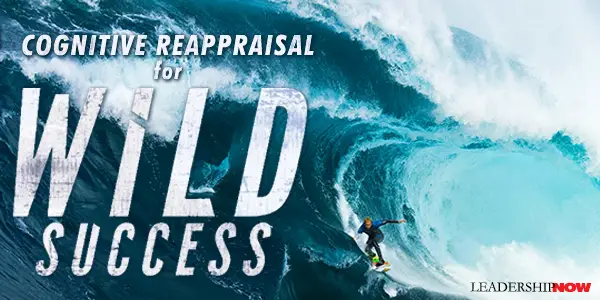
EXTREME adventurers have to perform at their best every time, or there might not be another time. They must be able to execute a plan under pressure. The same qualities that help them succeed will help any leader perform at a higher level and especially in a crisis situation. Wild Success by Amy Posey and Kevin Vallely illustrates seven leadership lessons we can learn from the harrowing experiences of extreme athletes. They are cognitive reappraisal, grit, learning from feedback, finding your spark, innovation, resilience, and building balance. I want to focus on a critical, but often difficult skill that we all need to develop: cognitive reappraisal. When you are looking at danger, uncertainty, and understandable fear, you need to be able to get perspective on what you’re facing. And when things go wrong, this discipline is even more critical. Posey and Valley introduce the experience of one of the best big wave surfers in the world, Australian Mark Mathews. Before Mark faces a dangerous wave like the slab wave he’s about to ride, “he performs a set pre-surf ritual to put his mind into focus. It’s something he does every time. ‘Fear is a big part of what I do,’ he says, ‘so dealing with it effectively is critical to my performance.’ Using simple breathing techniques to slow his mind down, Mark concentrates on feelings of excitement rather than anxiety, while reflecting on why he is doing what he is doing.” But on this day in 2016, Mark attempts to escape the wave, but the wave picked him up and slammed him feet first into the reef. Rushed to the hospital, the doctors find that the force of the blow has dislocated his knee, fractured his chin, ruptured his anterior and posterior cruciate ligaments, and ripped through his artery and nerve. They doubt they can save his leg. But with some luck they do, and he is treated for three months in the hospital. It looks like his career is over. But it isn’t. His ambitions have only grown. “What allows Mark to have the mental wherewithal to claw back from catastrophic injury and still have the fortitude to remain committed to the very thing that has hurt him so badly?” Cognitive reappraisal. Cognitive reappraisal is our ability to consciously manage our emotional experiences and responses to a setback or challenge and transform the negative emotions we feel into more positive ones. Cognitive reappraisal lets us not only acknowledge and reduce our emotional response to a negative situation, but it also changes our perspective on that situation by letting us take a step back and add a positive spin to whatever challenge we’re facing. Building this ability takes practice. Every setback is an opportunity to develop this mindset until it becomes a habit. For Mark, his “ability to positively reframe a situation both on and off the waves has come with lots of practice, and this practice developed a habit of cognitive reappraisal that served him well when he needed it most.” A habit of reframing a negative situation actually rewires your brain. A study by Columbia University professor Kevin Ochsner and his team found that when those who reframed a negative situation in a positive light, “their prefrontal cortex, the area of the brain integral to one’s cognitive behavior and emotional self-regulation, was activated by their reframing of the situation, while their amygdala, the area of the brain associated with fear and anxiety, saw a reduction in activity.” Negative events happen to us all. It’s normal to have an adverse emotional reaction—anger, hurt, self-doubt—at first. But if you can recognize the emotion in the moment—the shallow breathing, sweaty palms, an upset stomach—and make a choice to put cognitive reappraisal into action, you will take much of the stress out of the situation and allow for your creativity and to take hold and move forward in a more emotionally intelligent way. If we miss these symptoms [of stress] at the early stage, we quickly move into something called the emotional “point of no return,” where your emotions become fully activated, and reappraisal becomes exceptionally difficult. Practicing this anticipatory regulation during small and low-stakes stressors allows you to understand your own point of no return and [be better able to pull yourself] back from it. Cognitive reappraisal is a simple idea but very difficult to put into practice in the heat of the moment. But with some intentional practice, you can make it a habit that will serve you well in stressful and negative situations. 
Posted by Michael McKinney at 07:07 AM
04.24.20

Entrepreneurial Leadership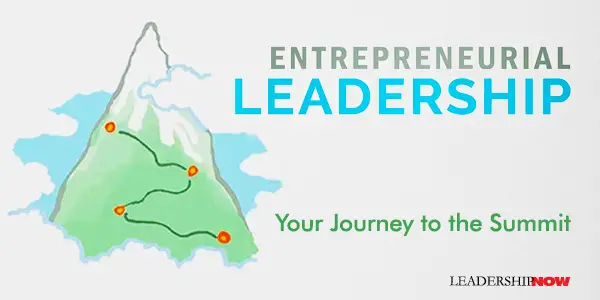
YOU don’t have to be an entrepreneur to be an entrepreneurial leader. Entrepreneurial leadership is a mindset. It is a mindset that is even more critical in today’s unstable world and is the sine qua non of crisis leadership. Joel Peterson has been around the block serving as a leader in various roles—CEO, CFO, founder, investor, entrepreneur—and is currently the chairman of JetBlue Airways and a professor at Stanford’s Graduate School of Business. Throughout it all, he says, he’s been lost more than once. “I’ve relied on more than one rescuer. And I’ve occasionally had to turn back, to recalibrate, to reboot. But over time, I’ve learned what to do—and how to think—when things don’t go as planned. I’ve figured out how to survive betrayal, miscalculation, and just plain bad luck. I’ve learned both how to live with disappointment and how to keep the occasional success from changing my values.” Through all of this, he’s “developed a framework—a set of principles, mindsets, and self-talk—that may help others on their quests.” He shares these in Entrepreneurial Leadership: The Art of Launching New Ventures, Inspiring Others, and Running Stuff. Five Types of Leadership To begin, he differentiates between five types of leadership: The Presider preside over the status quo and is a wise steward over the assets of the firm. The Manager excels at managing teams and delivering results without a limited focus on organizational strategy or trajectory. The Administrator manages process with predictability and efficiency. The Pure Entrepreneur starts things, innovates, and pilots with a mind to the future but often finds it difficult to scale or turn around a faltering organization. The Politician compromises, rationalizes, debates, and legislates and is skilled with the use of power. Peterson encourages the development of Entrepreneurial Leadership because these leaders are able to shift from one of the above styles to another as needed. In addition, they “demonstrate a particular mindset and approach to problem-solving. They are change agents. They are intentional, staying true to their vision and agenda rather than only reacting to day-to-day turbulence.” They are stewards and see their work as transformative. “Their work is messy, largely intangible, and never-ending. Each day brings new problems and new decisions that present ambiguity and shades of gray.” This type of forward-thinking, nimble leadership is needed now more than ever. Develop Your Leadership Around Four Activities He organizes his thoughts, approaches, and mindsets around four categories—four essential basecamps on the way to the peak of entrepreneurial leadership: 1. Build Trust
Entrepreneurial leaders build trust by knowing your core values—those things you spend your time, money, and mind share. And ask are any of these values getting in the way of your effectiveness. What guides your everyday actions? What is your personal operating system? “Next to knowing one’s core values, the most important attribute an entrepreneurial leader can possess is a predictable, reliable, and intentional personal operating system. If that operating system isn’t yet as reliable as the leader wants, refining it to that point should be a priority.” To create a mission, you have to describe three things that are unique about you: what you do, How you do it, and who you are. Set Memorable, Aligned, and Doable goals. In his entrepreneurial leadership classes, Peterson always asks his students: “What are you solving for? What is your objective?” Those who have clarity around winning tend to listen. They tend to compromise, to allow other parties to win, to sort out conflicts, and to arrive at solutions that allow everyone to move on. This means that entrepreneurial leaders are rarely perfectionists. Instead, they are practical problem solvers who keep their eyes on primary objectives. He most successful among them pursue strategies that are relentlessly aimed at achieving measurable results consistent with core values. Entrepreneurial leaders secure a team by hiring great people for values consistency and demonstrating effective attitudes—likability, gratitude, joyfulness, humility, humor—in their interactions. Delivering results is a matter of executing well on a number of challenges. Peterson covers ten of the most predictable: making decisions, selling, negotiating, raising capital, communicating, meetings, board relationships, overcoming adversity, surviving growth, and driving change.
A good entrepreneur will avoid the founder’s trap. In all likelihood, the company will grow beyond the capabilities of the founder and a founder should be prepared to turn it over to someone else at some point in time. Staying around past that point can ruin the company. Being an entrepreneurial leader can be exciting work, but becoming one “demands personal growth—no matter where you start—and along the way, you’ll likely discover more about the person you’d like to be and the meaningful work you want to do.” The world needs more entrepreneurial leaders to bring sustainable results. 
Posted by Michael McKinney at 07:24 AM
04.23.20

Leading Thoughts for April 23, 2020
IDEAS shared have the power to expand perspectives, change thinking, and move lives. Here are two ideas for the curious mind to engage with: John W. Gardner on dealing with the divisions in our society: “No society can successfully resolve its internal conflicts if its only asset is cleverness in the management of these conflicts. It must also have compelling goals that are shared by the conflicting parties; and it must have a sense of movement toward these goals. All conflicting groups must have a vision that lifts their minds and spirits above the tensions of the moment.” Source: Excellence: Can We Be Equal and Excellent Too? In a tribute to John Foster Dulles who died on May 24, 1959, Walter Lippmann comments on the duty of public servants: “Perhaps the highest function of a public servant in a free and democratic society is to preserve its oneness as a community while he fights the battle which divide it. John Foster Dulles never lost sight of that. He never forgot, as so many public men do, that after the issue which is up for debate is settled, those who took part in the debate must still live and work together. That is the reason way among his countrymen there is no rancor, and why the sorrow of his opponents and critics is genuine.” Source: Dulles: A Tribute, Today and Tomorrow, May 26, 1959 Look for these ideas every Thursday on the Leading Blog. Find more ideas on the LeadingThoughts index.
Posted by Michael McKinney at 07:22 AM
04.20.20

We Live in A Downstream World
You and a friend are having a picnic by the side of a river. Suddenly you hear a shout from the direction of the water—a child is drowning. Without thinking, you both dive in, grab the child, and swim to shore. Before you can recover, you hear another child cry for help. You and your friend jump back in the river to rescue her as well. Then another struggling child drifts into sight … and another … and another. The two of you can barely keep up. Suddenly, you see your friend wading out of the water, seeming to leave you alone. “Where are you going?” you demand. Your friend answers, “I’m going upstream to tackle the guy who’s throwing all these kids in the water.” THIS metaphor sets the premise for Dan Heath’s book Upstream: The Quest to Solve Problems Before They Happen. We live in a downstream world. We have a bias for downstream action. We spend most of our time reacting to problems downstream rather than dealing with the source of the problem that is found upstream. Heath argues that “we should shift more of our energies upstream: personally, organizationally, nationally, and globally. We can—and we should—stop dealing with the symptoms of problems, again and again, and start fixing them.” That seems pretty obvious. So why don’t we? Time after time, we find ourselves reacting over and over again. Heath identifies three barriers to upstream thinking: Problem Blindness Problem blindness assumes that the problem is natural or inevitable, and there’s nothing you can do about it. And we shrug it off. “That’s just the way it is,” we conclude. So, we don’t try. “When we don’t see a problem, we can’t solve it. And that blindness can create passivity even in the face of enormous harm.” A Lack of Ownership Complacency. What problems do we see around us that we could fix, but don’t? Moving upstream requires that we take ownership of the issues personally. “I choose to fix this problem, not because it’s demanded of me, but because I can, and because it’s worth fixing.” Tunneling Tunneling is a condition where you find that “when people are juggling a lot of problems, they give up trying to solve them all. They adopt tunnel vision. There’s no long-term planning; there’s no strategic prioritization of issues.” When we are in a negative or scarcity mindset, we become “less insightful, less forward-thinking, less controlled.” Here are listed seven fundamental questions that upstream leaders must answer:
In clarifying these questions, Heath reveals some of the big issues through a wide variety of case studies that keep us from moving upstream. Part of what makes downstream efforts so popular is that the results are quite tangible. “Downstream efforts restore the previous state.” If my relationship is broken, and I fix it, the intervention was a success. If I do take preventative measures, I’m fixing what may or may not have happened. The issue arises, too, that I’m putting effort into something that is not broken. Is that necessary? We pay to fix problems, but we are not as keen to put money into preventing problems. “We can pay to fix problems once they happen, or we can pay in advance to prevent them. What we need are more businesses and social entrepreneurs who can figure out how to flip payment models to support the preventive approach.” There is uncertainty in fixing upstream problems, especially when they are not reoccurring. When preparing for a distant threat, it’s often difficult to tell if we are avoiding a disaster or preparing for something that will never happen. Is it worth the effort? “Organizations are constantly dealing with urgent short-term problems. Planning for speculative future ones is, by definition, not urgent. As a result, it’s hard to convene people. It’s hard to get funds authorized. It’s hard to convince people to collaborate when hardship hasn’t forced them to.” Heath asks, “How can you personally move upstream?” He recommends that we “be impatient for action but patient for outcomes.” We need to get moving, but often the change we seek takes time. Also, “macro starts with micro.” Break the action down. Get specific. And finally, “favor scoreboards over pills.” Think in terms of continuous improvement. “Data for learning” rather than “data for inspection.” Test and learn and test again. Upstream is a direction, not a destination. Any movement upstream is a step in the right direction. You can get a little ahead of the problem by or you can go further upstream and look for the more systemic issues. “When there’s a recurring problem in your life, go upstream.” When we don’t deal with problems upstream, we are destined to deal with them over and over again. 
Posted by Michael McKinney at 11:07 PM
04.16.20

Leading Thoughts for April 16, 2020
IDEAS shared have the power to expand perspectives, change thinking, and move lives. Here are two ideas for the curious mind to engage with: Jack Trout on the simple approach to success: “Trying harder, believing in yourself, walking on fire, and saying, ‘yes I can’ are not steps up the ladder of success. The surprising truth is that success does not spring from anything inside yourself at all. Success is something given to you by others. Source: The Power of Simplicity by Jack Trout with Steve Rivkin Jack Welch on communicating simply: “For a large organization to be effective, it must be simple. For a large organization to be simple, its people must have self-confidence and intellectual self-assurance. Insecure managers create complexity. Frightened, nervous managers use thick, convoluted planning books and busy slides filled with everything they’ve known since childhood. Real leaders don’t need clutter. People must have the self-confidence to be clear, precise, to be sure that every person in their organization—highest to lowest—understands what the business is trying to achieve. But it’s not easy. You can’t believe how hard it is for people to be simple, how much they fear being simple. They worry that if they’re simple, people will think they’re simpleminded. In reality, of course, it’s just the reverse. Clear, tough-minded people are the most simple.” Source: Harvard Business Review: Speed, Simpicity, Self-Confidence: An Interview with Jack Welch Look for these ideas every Thursday on the Leading Blog. Find more ideas on the LeadingThoughts index.
Posted by Michael McKinney at 09:43 AM
04.14.20

The 3 Types of Humility That Impact Your Leadership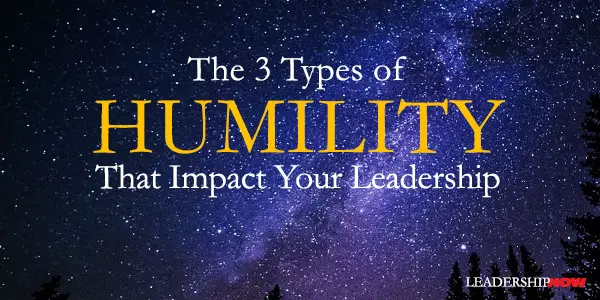
IN 2016, Harvard Business School Dean Nitin Nohria addressed the graduating class and spoke of three H’s: Hope, Humility, and Honor. These three qualities are reflected in leaders who make a difference. In speaking about hope, he turned to the example of explorer Ernest Shackleton, who, in a seemingly hopeless situation, “continued not only to remain optimistic himself, but he continually instilled hope in his crewmates. He refused to let them give in to the despair that logic would lead them to feel. He did not allow them to give up, either emotionally or physically.” He said we should think of honor as a verb. It’s an action. It’s about “making and keeping commitments.” What stood out for me was the way he broke down humility into three types: Intellectual, Moral, and Personal. It gives one a multi-faceted picture of humility and how we might cultivate this quality more fully in our lives.
How might we see our own lives differently from these three perspectives on humility?
Posted by Michael McKinney at 06:11 PM
04.12.20

Self-Made: The Story of Madam C.J. Walker
NETFLIX brings to life the entrepreneurial success story of African American entrepreneur and philanthropist Madam C.J. Walker. The four-hour mini-series Self-Made starring Oscar-winner Octavia Spencer is based on Walker's great-great-great-granddaughter A’Lelia Bundles book, On Her Own Ground: The Life and Times of Madam C.J. Walker. Madam C.J. Walker was born Sarah Breedlove on December 23, 1867, on a plantation in Delta, Louisiana, to former slaves-turned sharecroppers after the Civil War. Her rags-to-riches story is inspiring and a testimony to hard work, persistence, and resourcefulness. Seeking a way out of her poverty, she became a washerwoman and cook. Eventually moving to Denver, Colorado, she married ad-man Charles Joseph Walker and renamed herself “Madam C.J. Walker.” With $1.25, she created a line of hair products and straighteners for African American women and became one of America’s first self-made female millionaires. As her business grew, she applied her success to philanthropy giving to organizations focused on the social well-being of Black Americans. She also gave six scholarships to the Tuskegee Institute. Walker died of kidney failure and complications due to hypertension on May 25, 1919. Her estate was valued at about ten million dollars. While Self-Made successfully brings awareness to Walker’s life and accomplishments, it is a dramatized story—facts are compromised, but the essence is there. It is a good look into the entrepreneurial mindset. If you want to know more about her life, you might start with Oprah Magazine’s What Self Made Got Right—and Wrong—About Madam C.J. Walker. Madam C.J. Walker on the business of life:
Posted by Michael McKinney at 12:25 PM
04.09.20

Leading Thoughts for April 9, 2020
IDEAS shared have the power to expand perspectives, change thinking, and move lives. Here are two ideas for the curious mind to engage with: Management professor and social philosopher Charles Handy on the inevitability of paradox: “We need a new way of thinking about our problems and our futures. My suggestion is the management of paradox, an idea which is itself a paradox, in that paradox can only be “managed” in the sense of coping with. Source: The Age of Paradox John Silber, former President and Chancellor of Boston University, on the role of journalists: “Like all of us, journalists are subject to the temptations of power. Power tends to corrupt them no less than it corrupts politicians. And as the fourth estate has become vastly more powerful through television, the journalists in the electronic media should be aware of their increasing vulnerability to corruption. Many journalists come to think of themselves not so much as objective reporters but as the loyal opposition. But this is not the proper function of reporters. The adversary relationship is not a relationship of objectivity. To be in opposition may be the duty of a politician or a party, but it is a violation of the responsibility of the journalist, which is to report on what happens as objectively and as dispassionately as possible.” Source: Straight Shooting: What’s Wrong with America and How to Fix It Look for these ideas every Thursday on the Leading Blog. Find more ideas on the LeadingThoughts index.
Posted by Michael McKinney at 04:37 PM
04.08.20

How to Hold onto Your Customers in a Crisis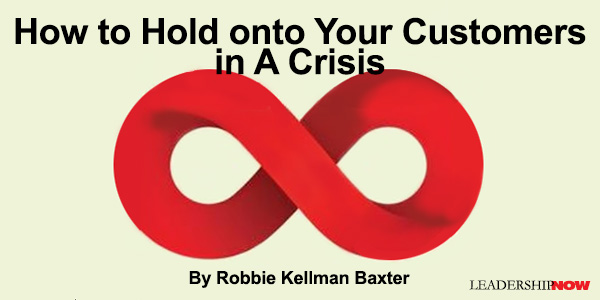
SUBSCRIPTION-BASED businesses seem to be the most resilient during this time of crisis. With predictable recurring revenue, they have greater flexibility to withstand the storm. But there’s more to it than just revenue. To hang onto customers during a crisis, you need to build a forever transaction with the people you serve. Your team has to know what your “forever promise” is—the organization’s commit-ment to customers that justifies customer loyalty. If you don’t have a forever promise, you’re sunk. I’ve observed companies panicking and doing anything they can to manage short-term cash—and destroying hard-earned relationships at lightning speed. Companies are making bad decisions for good reason. They are letting short-term financial objectives become the North Star in an effort to keep the lights on. But when the dust settles, they will have lost the trust that makes customer loyalty possible. And, they will have lost the trust of the employees they’ve counted on for years to serve those customers with grace, passion, and perseverance. Customers will remember which hotels and theaters offered a refund on unusable reservations, which newspapers dropped their paywall and provided free content, and which gyms quickly mobilized to send out daily video fitness classes. They will also remember the companies that took advantage of the crisis by gouging on price. Or those that laid-off employees with little to no notice, leaving these formerly loyal workers to fend for themselves when their rents and mortgage payments came due. In times of crisis, relationships become much more volatile—people can quickly move from love to hate with a company that lets them down. In these times, customers are quicker to connect, let their guards down, and trust. But these same customers are also quicker to end their relationship forever with a company that violates their trust. Reputations that took years to build can be destroyed in two weeks. Relationships that used to take years to unravel can unravel in days. On the other hand, companies that have a long-term focus and take good care of their customers and employees during a crisis win lasting loyalty. This phenomenon is especially powerful for subscription businesses and any business—subscription or not—that has a true “membership mindset.” Companies with a membership mindset do everything they do with the objective of creating long-term value for each and every customer. Their businesses are not comprised of anonymous transactions, and their customers are not just an account number or the next person in line. Every customer is a special person with special needs, who is a pleasure to serve. Those that have predictable recurring revenue streams are better positioned to survive the crisis. Products and services people subscribe to are used by customers on an ongoing basis, which means that they’re habits—so customers are less likely to stop. Also, it takes more energy to proactively make a decision to buy than to make a decision to stop paying for something that has already been decided. In this crazy time, some businesses have seen a massive spike in demand. Video communications, headset manufacturers, content creators, delivery services, and manufacturers of cleaning supplies, face masks, and toilet paper are inundated with new demand. For these organizations, the question is how to turn this spike into an ongoing relationship. Hint: It’s not by price-gouging…it’s by onboarding these new members to stay for the long-term. Here are six things you can do right now to build and maintain strong customer relationships during this crisis.
 
Posted by Michael McKinney at 07:57 AM
04.06.20

Dealing with the Two Fronts of Every Crisis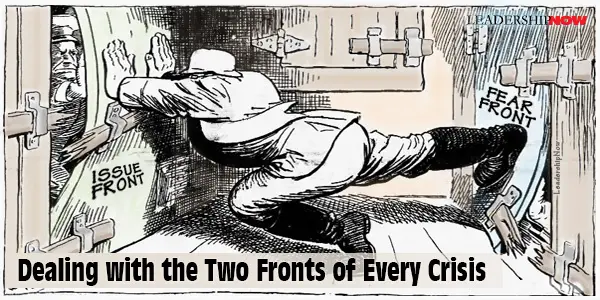
EVERY CRISIS places a leader between two fronts: Issue and Fear. Understanding the difference and managing both is key to dealing with a crisis successfully. There are different kinds of crises, but this dynamic applies to both types. There is the crisis where the issue is known, there is a procedure for handling it, and success in dealing with it comes down to proper execution of the solution. A “routine risk event” can be accompanied with fear, but it rarely evolves into panic as uncertainty is minimal. A true crisis event is different because we lack familiarity with it and there are, as crisis expert Harvard Business School Professor Herman “Dutch” Leonard puts it, “significant elements of novelty to it.” He says as there is no precedent for it, there is no playbook for handling it. There is no script for managing it. In a true crisis, you are faced with rapid, real-time innovation under stress “embedded in fear.” He adds, “That’s a fundamentally different kind of human challenge. It feels chaotic and unsettling, and that’s the way it always feels.” This is where we find ourselves now in April of 2020—a true crisis. The Issue Front A true crisis has many moving parts that lack connection. There is no playbook. Unlike a routine risk event where you have figured out in advance what the key issues are and which ones take precedence, in a true crisis event, you will often see, says Dutch, “competing priorities which you have never had to trade-off before. You have a whole bunch of things that are colliding simultaneously, and you haven’t necessarily had a chance—in previous experience—to sort out which is most important.” Dutch says what crisis management needs is not answers but an effective process. This idea is encapsulated in his phrase, “learning our way forward.” Because of this, we won’t get it right the first time. We simply don’t know. We might speculate, but we don’t know. In some ways, we are operating blind in a crisis, and this often generates a great deal of uncertainty and fear. We must learn to push through the fear and trust in the process. Dutch says organizations need to approach the crisis with a more “entrepreneurial, innovative, and forward-looking leadership stance and convene a process to solve these problems in real-time. The process consists of the people you bring together and the way they interact.” A crisis management team needs to consist of three categories of people. First, you need people who understand the goals and priorities of the organization so as to get all of the concerns out on the table. Second, you need people who know about the crisis. These can be people inside the organization, but depending on the nature of the crisis, more often than not, they will need to be credible people from outside the organization. And finally, you need people who really understand your organization—how it works—how things get done. Together these three groups of people can talk about what we care about, what is the actual situation, and how we as an organization fit into and relate to the crisis. This discussion helps keep everyone centered and serves as a guide to execution. Dutch notes that this team doesn’t get into problem-solving but is tasked with understanding the issues overall. The problem-solving is delegated but delegated in a way that none of the important issues are missed in finding a solution. A crisis calls for agile leadership. Select options, try them, get feedback, and try again—a problem-solving experimental approach. It is learning our way forward. “We are learning as fast as we can. We must avoid quick answers. We get better as we move along.” Leaders must have a learning-oriented, process-based mindset, and this thinking must be communicated to everyone affected by the crisis, to effectively deal with the Fear Front. The Fear Front The critical skill a leader must possess is the ability to separate the signal from the noise. It is the noise that generates the most fear. While there will always be some degree of anxiety, the fear that often leads to panic diminishes our ability to respond and to be patient in working out the response. Fear reduces clarity and trust in the process. We become gullible and self-centered. Fear cripples us. Here are several ways to help fight fear: Always Keep the Big Picture in Mind When dealing with a pandemic, The World Health Organization is concerned not only about the disease itself but the problem of combating the infodemic, which they define as “an overabundance of information—some accurate and some not—that makes it hard for people to find trustworthy sources and reliable guidance when they need it.” In The Signal and the Noise, statistician and New York Times contributor Nate Silver explains that “if the quantity of information is increasing by 2.5 quintillion bytes per day, the amount of useful information almost certainly isn’t. Most of it is just noise, and the noise is increasing faster than the signal. There are so many hypotheses to test, so many data sets to mine—but a relatively constant amount of objective truth.” Not that new evidence will never outweigh all other data and theories, it can, but we tend to “focus on the newest or most immediately available information, and the bigger picture gets lost,” writes Silver. This tendency narrows our view and sends our emotions into a downward spiral if not checked. Keeping the big picture in mind will help us to make measured choices and build trust in the process. Educate to Bring Clarity Leaders provide clarity by informing and educating people on what they know and how they fit into the issue. In the absence of credible information, people tend to gravitate to the worst-case scenario. In his first address to the nation since his Pearl Harbor address on December 7, 1941, Franklin Roosevelt was compelled to inform and educate the American people of the issue. He wanted to provide the big picture. He said, “I’m going to ask the American people to take out their maps. I’m going to speak about strange places that many of them have never heard of—places that are now the battleground for civilization. I want to explain this war in laymen’s language; if they understand the problem and what we are driving at, I’m sure that they can take any kind of bad news right on the chin.”
Roosevelt saw the morale of the American people as his responsibility. His intent was to drive out fear by education and consistent communication. The Crisis Industry—those journalists, politicians, and experts that seek to profit from a crisis—was alive and well in FDR’s time too, and education is the only way to combat it. Remain Steady Communicate the uncertainty. We don’t know, and that’s part of the process. There is a joke about the statistician that drowned crossing a river that was only three feet deep on average. Predictions can only be at best approximations based on current data, and even that can be manipulated if it is not placed in its proper context. All data exists in a relationship to other facts. Over time these relationships add clarity. As we gather more and more data, we come closer to the truth. Blame has no place in leadership. Blame is a form of panic. It is silly to blame others in a situation where the answers are not known, and opinions are rampant. Blame is not leadership; it is reactionary and only impedes the way to a solution. Look for the positive events in the crisis. It will help you to clarify and minimize, if not solve, the remaining negative issues. Make People Agents of Something Positive People’s anxiousness comes from the sense that things are out of control, and they have no capacity to direct the course of their lives. Leaders must speak to that anxiety, give hope, and pull the issues down to the realm of personal responsibility. What can I do now? In The Splendid and the Vile, historian Erik Larson shares that John Martin, one of Winston Churchill’s secretaries, wrote in his diary about Churchill, “Under his leadership Britons began to see themselves as ‘protagonists on a vaster scene and as champions of a high and invincible cause.’” Larson explains how Churchill helped people manage their fears at the beginning of WorldWar II: Recognizing that confidence and fearlessness were attitudes that could be adopted and taught by example, Churchill issued a directive to all ministers to put on a strong, positive front. “In these dark days the Prime Minister would be grateful if all his colleagues in the Government, as well as high officials, would maintain a high morale in their circles; not minimizing the gravity of events, but showing confidence in our ability and inflexible resolve to continue the war till we have broken the will of the enemy to bring all Europe under his domination.” Fear is contagious and has an exponential effect. Nigel Hamilton writes in The Mantle of Command, that FDR felt, “A leader must exhibit confidence since the slightest hint of anxiety or dejection would spread like ripples in a pond.” When we deal with the crisis with a positive expectation and manage the fear, we open ourselves up to possibility, opportunities, and self-efficacy. The crisis will past, of course, but our experience of it and our success in solving it depends on how we respond to it and manage the fear. As leaders, how can we become beacons of hope for our families and organizations? To help people embrace the future and not the past?
Posted by Michael McKinney at 03:31 PM
04.04.20

Need More Drama?
IN CASE the media isn't providing enough clickbait and drama in your life, we resurrect this advertising gem from 2012. The backstory: For the launch of the high-quality TV channel TNT in Belgium, a button was placed on an average Flemish square of an average Flemish town near a sign with the text "Push to add drama" that invited people to use the button. Then they waited...
Posted by Michael McKinney at 07:19 PM
04.03.20

Are You Ready for Recovery?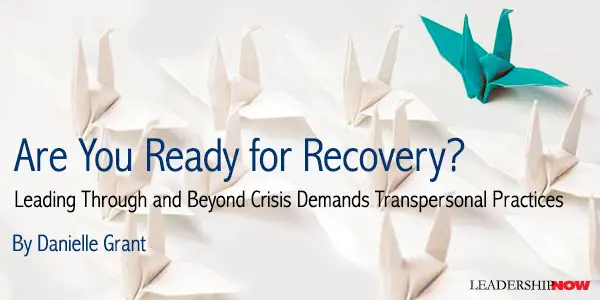
AS a McKinsey & Company article stated in late March 2020: “What leaders need during a crisis is not a predefined response plan but behaviors and mindsets that will prevent them from overreacting to yesterday’s developments and help them look ahead.” McKinsey cites 5 practices or mindsets that will enable leaders to bring their organizations through any turbulent times. This article will show how those who develop as transpersonal leaders are those who are best prepared to do this. Transpersonal Leadership is a concept that my colleagues and I at LeaderShape Global have been developing for over 10 years. It is an approach that was born out of many years’ experience as corporate leaders ourselves and our experience developing organizational leaders using Emotional Intelligence approaches. We realized that leaders could be emotionally intelligent but also manipulative and self-serving. This phenomenon is driven by excessive egos that want power, prestige, recognition, and reward. While there is nothing wrong with these drivers, per se, when they are the dominant force in decisions, rather than the needs of the organization and its stakeholders (including the community and the planet), then the problems arise. This is when the incidence of corporate scandals increases, as we have all seen in recent years. A Transpersonal Leader operates beyond their own ego and personal drivers and balances the needs of all the organization’s stakeholders. This means they are making decisions in full consciousness of their sense of purpose, ethics, and values. Mindset This approach self-evidently enables a mindset that offers a long-term perspective. Because, if leaders are balancing the needs of stakeholders in a values-conscious way, they will not cut corners or put short term gains at the forefront of decisions. This meets the need to slow down and not overreact. It naturally gives them the tendency to look ahead at or beyond the immediate horizon. It also means that leaders whose ego is not in the driving seat will have the humility to appreciate that in a crisis (especially), they do not have all the answers and that Leadership and decision-making needs to be distributed to those who have the best knowledge and information. Those who are driven by their ego, for example, will take center stage and proclaim to have the answers, ignoring or side-lining the experts who could give a more realistic assessment of a situation, managing people’s expectations. The leader who is transpersonal will value the expertise of those around and enable that to be disseminated to achieve the best outcome. “During a crisis, leaders must relinquish the belief that a top-down response will engender stability.” —McKinsey Involve More People The next area to consider is the crucial importance of distributed Leadership, which follows naturally from the transpersonal perspective. To explain further, in a crisis, using diverse perspectives enables the unthinkable to be brought to the table, it avoids groupthink and enables more effective solutions. One way to devolve leadership in times of crisis is through the organization of a network of teams that can tackle discrete responsibilities and are empowered to communicate with each other to create a complete picture before coming to decisions. Decisions that they are authorized to take. That’s right, without a need for approval from the top. To achieve this requires not just the humility previously referred to but also transparency, trust, and effective communication. A transpersonal leader has travelled a road where these attributes have been developed, alongside a honed appreciation of how to improve judgment and decision making. The transpersonal leader learns that we have 5 decision-making processes, of which only one is conscious. Harnessing and bringing into greater awareness, the processes that lie below consciousness enables them to detach from their emotional reactions or unconscious biases. This allows them to take a pause, stand back and allow the distributed responsibilities to be exercised by teams that they have assembled, using all these capacities.
So, the transpersonal leader can use their own touchstone of values and self-determination to have the confidence in backing decisions and making any tough calls along the way. Such a leader will appreciate the level of thinking from empowered teams of experts. This shared understanding of how well-considered decisions are made results in both sides trusting the other. The environment of psychological safety and optimism which follows from these principles, becomes an underpinning enabler. “Leaders with the right temperament and character are necessary during times of uncertainty. They stay curious and flexible but can still make the tough calls, even if that makes them unpopular. They gather differing perspectives and then make the decisions, with the best interests of the organization (not their careers) in mind, without needing a full consensus.” —McKinsey The Transpersonal Touchstone Explored Each of us will have our own list of core values that we can populate the touchstone with. Here is one example from a leader. Some of the values on the left are integral to them; other things they are keen to develop. Which might yours be? The qualities on the right represent the way the transpersonal leader brings their values into the world and guides their actions.
Checking thinking and decisions against one’s own values and the transpersonal qualities is the foundation. This stepping back to gain clarity creates the sound mindset and behaviours that are indispensable in leading through and out the other side of any crisis. It allows boldness to be tempered with just enough prudence to maximize the upsides of the situation. Anybody can travel the path to Transpersonal Leadership. The journey is ideally taken with the support of an accredited Transpersonal Leadership Coach. It is a path you can choose to follow to lead your organization out of the depths of a crisis through to the sunny uplands of recovery.  
Posted by Michael McKinney at 03:17 PM
04.02.20

Leading Thoughts for April 2, 2020
IDEAS shared have the power to expand perspectives, change thinking, and move lives. Here are two ideas for the curious mind to engage with: A philosopher at Oxford University, Toby Ord explains the risks we are taking here on spaceship earth: “We have done many things to exacerbate the risk: some that could make pandemics more likely to occur, and some that could increase their damage. Thus even “natural” pandemics should be seen as a partly anthropogenic risk. Our population now is a thousand times greater than over most of human history, so there are vastly more opportunities for new human diseases to originate. And our farming practices have created vast numbers of animals living in unhealthy conditions within close proximity to humans. This increases the risk, as many major diseases originate in animals before crossing over to humans. Examples include HIV (chimpanzees), Ebola (bats), SARS (probably bats) and influenza (usually pigs or birds). Evidence suggests that diseases are crossing over into human populations from animals at an increasing rate. Source: The Precipice: Existential Risk and the Future of Humanity Franklin Delano Roosevelt on fear in a time of crisis: “This great Nation will endure, as it has endured, will revive and will prosper. So, first of all, let me assert my firm belief that the only thing we have to fear is fear itself — nameless, unreasoning, unjustified terror which paralyzes needed efforts to convert retreat into advance. In every dark hour of our national life, a leadership of frankness and of vigor has met with that understanding and support of the people themselves which is essential to victory. And I am convinced that you will again give that support to leadership in these critical days.” Source: Franklin Delano Roosevelt's First Inaugural Address on March 4, 1933 Look for these ideas every Thursday on the Leading Blog. Find more ideas on the LeadingThoughts index.
Posted by Michael McKinney at 08:56 AM
04.01.20

First Look: Leadership Books for April 2020Here's a look at some of the best leadership books to be released in April 2020. Don't miss out on other great new and future releases.
Many leaders see their roles as presiders/managers, with a primary focus on keeping results consistent with past performance and on budget. These kinds of leaders make important contributions but rarely leave a mark on the businesses they serve. For those wanting to make a lasting impact, new skills are required. They need to learn to launch new initiatives, inspire others, and champion innovative approaches. Joel Peterson calls these higher-level leaders “entrepreneurial leaders,” and they create durable enterprises that deliver on their promise. Peterson lays out a path to achieving this summit, with a series of leadership maps organized around the four essential basecamps on the path to Entrepreneurial Leadership:
A former rocket scientist reveals the habits, ideas, and strategies that will empower you to turn the seemingly impossible into the possible. Rocket science is often celebrated as the ultimate triumph of technology. But it's not. Rather, it's the apex of a certain thought process—a way to imagine the unimaginable and solve the unsolvable. It's the same thought process that enabled Neil Armstrong to take his giant leap for mankind, that allows spacecraft to travel millions of miles through outer space and land on a precise spot, and that brings us closer to colonizing other planets. Fortunately, you don't have to be a rocket scientist to think like one. In this accessible and practical book, Ozan Varol reveals nine simple strategies from rocket science that you can use to make your own giant leaps in work and life.
The definitive book on leadership in the digital era: why digital technologies call for leadership that emphasizes creativity, collaboration, and inclusivity. Certain ideas about business leadership are held to be timeless, and certain characteristics of leaders―often including a square jaw, a deep voice, and extroversion―are said to be universal. Amit Mukherjee argues that since digital technologies are changing everything else, how could they not change leadership ideologies and styles? As more people worldwide participate equally in business, those assumptions of a leader's ideal profile have become irrelevant. Offering a radical rethinking of leadership, Mukherjee shows why digital technologies call for a new kind of leader―one who emphasizes creativity, collaboration, and inclusivity.
Leading futurist Bob Johansen shows how a new way of thinking, enhanced by new technologies, will help leaders break free of limiting labels and see new gradients of possibility in a chaotic world. The future will get even more perplexing over the next decade, and we are not ready. The dilemma is that we're restricted by rigid categorical thinking that freezes people and organizations in neatly defined boxes that often are inaccurate or obsolete. Categories lead us toward certainty but away from clarity, and categorical thinking moves us away from understanding the bigger picture. Sticking with this old way of thinking and seeing isn't just foolish, it's dangerous. Full-spectrum thinking is the ability to seek patterns and clarity outside, across, beyond, or maybe even without any boxes or categories while resisting false certainty and simplistic binary choices. It reveals our commonalities that are hidden in plain view.
Innosight's Mark W. Johnson and Josh Suskewicz introduce a new way of thinking and managing, called "future-back," that enables any manager to become a practical visionary. Addressing the many barriers to change that exist in established organizations, they present a systematic approach to overcoming them that includes: The principles and mind-set that allow leadership teams to look beyond typical short-term planning horizons / A method for turning emerging challenges into the growth opportunities that can define an organization's future / A step-by-step approach for translating a vision into a strategic plan that teams can align around and commit to / Ways to ensure that visionary thinking becomes a repeatable organizational capability
We're often told that we're living amidst a startup boom. Typically, we think of apps built by college kids and funded by venture capital firms, which remake fortunes and economies overnight. But in reality, most new businesses are things like restaurants or hair salons. Entrepreneurs aren't all millennials—more often, it's their parents. And those small companies are the fabric of our economy. This book is the real story of entrepreneurship. It confronts both success and failure, and shows how they can change a human life. It captures the inherent freedom that entrepreneurship brings, and why it matters.
 Build your leadership library with these specials on over 32 titles. All titles are at least 40% off the list price and are available only in limited quantities. “There is more treasure in books than in all the pirate’s loot on Treasure Island.” — Walt Disney
Posted by Michael McKinney at 08:16 AM
|
BUILD YOUR KNOWLEDGE


How to Do Your Start-Up Right STRAIGHT TALK FOR START-UPS 
Grow Your Leadership Skills NEW AND UPCOMING LEADERSHIP BOOKS 
Leadership Minute BITE-SIZE CONCEPTS YOU CAN CHEW ON 
Classic Leadership Books BOOKS TO READ BEFORE YOU LEAD |
|